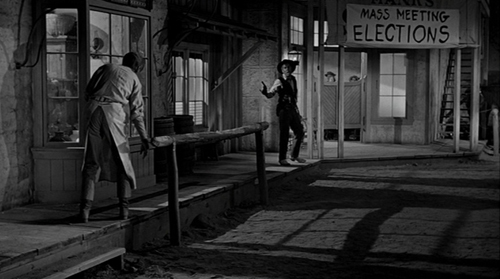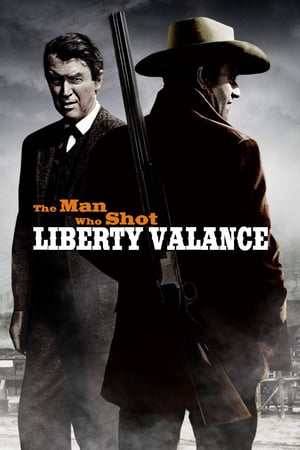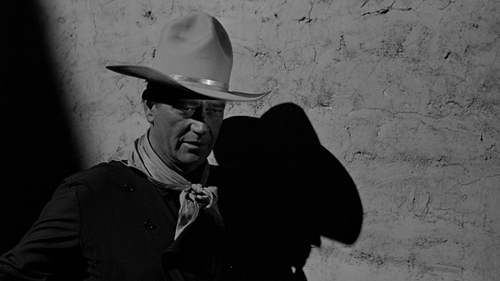
Your complimentary articles
You’ve read one of your four complimentary articles for this month.
You can read four articles free per month. To have complete access to the thousands of philosophy articles on this site, please
Films
The Man Who Shot Liberty Valance
Thomas E. Wartenberg sees current concerns about truth in the news spotlighted by a classic Western.
It’s rare that current events change our appreciation of a classic Hollywood film, but that’s exactly what’s happened over the past two years with regard to my perception of John Ford’s Western, The Man Who Shot Liberty Valance (1962). In the age of ‘fake news’, this film’s examination of the transformation of the role of the newspaper from a courageous purveyor of truth to an ignominious peddler of falsehoods demands our attention.
So engaging are the central scenes of the film’s narrative that viewers sometimes forget that what they’re watching is an extended flashback narrated by Senator Ranse Stoddard (Jimmy Stewart), in which he explains why he and his wife Hallie (Vera Miles) have returned to Shinbone for the funeral of town drunk Tom Doniphon (John Wayne). In a great sequence in which the outlaw Liberty Valance’s death is depicted in the film for a second time – this time from a point of view that establishes who actually fired the shot that killed him – Doniphon explains to Stoddard that he gunned down Valance in cold blood from an alley. Everyone had assumed that Stoddard himself had killed Valance in self-defense on the main street – including us viewers, when we first watch the event from a viewpoint on the street. Because he had murdered Valance, rather than shooting him in self-defence, Doniphon had to conceal his role, lest he be prosecuted. As a result, Stoddard gains an unearned reputation as the man who heroically shot Liberty Valance – a reputation that eventually propels him into the US Senate.

Valance images © Paramount Pictures 1962
Important as the events in the body of the film are, it’s the frame that interests me here. For the frame, which depicts events taking place decades after Valance’s death, has an uncanny contemporary relevance.
The frame begins with Ranse and Hallie Stoddard arriving in the much transformed Shinbone by train, a conveyance that the town lacked when the couple lived there in Valance’s time. When news that the Senator is in town spreads, the Editor of The Shinbone Star, Maxwell Scott (Carleton Young), and some of his reporters, ask Ranse Stoddard why he has come back. What they can’t figure out is why such an eminent person as Stoddard would have returned to town after so long for the funeral of an obscure drunk.
As he wipes the dust off the very stage coach that first brought him west to Shinbone – in contrast to his current arrival on the train – Stoddard recites the tale whose central event is Valance’s shooting by Doniphon. As he ends his tale, he asks Scott whether he’s going to print the story he has just heard – and reveal to the public who really shot Valance. Stoddard wants the record set straight, it seems, because he has borne guilt all these years for profiting from a reputation he didn’t deserve. Not only that, but he has been married to a woman who was, when he first met her, Doniphon’s girl, so it’s not just his reputation he doesn’t really deserve. What’s more, these events resulted in Doniphon’s decline into alcoholism. When we first see Doniphon, he’s a brash young man who seems to have the world at his feet. Scott’s reply has an ominous resonance for us in our present media climate. Scott says that he’s not going to use the new revelations. “No, sir,” he replies. “This is the West, sir. When the legend becomes fact, print the legend.”

Although this line has long been a classic, it takes on a different significance in the age of fake news. We can get at this by comparing Scott, the current editor of The Shinbone Star, to Dutton Peabody (Edmund O’Brien), who edited The Star during the time of the flashback narrative. At that time, a war was raging between the townspeople and the cattleman – a typical theme for Westerns, originating in a real conflict in the American West during the mid to late nineteenth century. Valance was a hired gun for the cattlemen. The Star printed stories that were not in the cattlemen’s interest, and Valance was sent to intimidate Peabody by burning the press and beating him up. But Peabody was undeterred by Valance’s violence. Although a drunk, he was committed to using his paper to tell people the truth about what was transpiring in their town. The following quote comes from a comic scene, but reflects Peabody’s sense of the mission of his newspaper:
“Good people of Shinbone, I… I… I’m your conscience – I’m the still, small voice that thunders in the night. I’m your watchdog that howls against the wolves! I’m – I’m your father confessor.”
It’s Peabody’s commitment to ‘howling against the wolves’ that makes him such a threat to the cattlemen that they send Valance to ransack the press and beat him to a pulp. In this the film suggests that a free press is an important stay against moneyed interests, by exposing their exploitation to the public scrutiny.
The film also depicts a free press as central to a democratic society, albeit in comic terms. During the election for a representative to a Convention that will allow the Territory to become a State, Peabody attempts to get a drink:
Peabody: [during voting] I’ll have the usual, Jack.
Barman: The bar is closed, Mister Editor, during voting.
Peabody: Bar’s closed?
Doniphon: You can blame your lawyer friend [Stoddard]. He says that’s one of the ‘fundamental laws of democracy’. No exception.
Peabody: No exceptions for the working press? Why, that’s carrying democracy much too far!
Humorous as this exchange is, it foregrounds the idea of democracy as central to developing America society. If Shinbone is to become a part of the United States (as we know it will), it has to live up to the democratic values inherent in American society. And Peabody, as the Editor of the town’s paper, has to embody those values himself, no matter how hard it is for him to do that.

By the time the Stoddards return to Shinbone in the early twentieth century the transformation of the small town into a thriving city is complete. A change in the mission of the newspaper is equally fundamental, and much more ominous. Scott’s decision to ‘print the legend’ signifies the replacement of truth as the paper’s core value. Supporting the status quo has become the central mission of The Shinbone Star instead – a fact we realize as Scott rips up the notes his reporter took during Stoddard’s narration.
In our current political climate, rewatching The Man Who Shot Liberty Valance strikes an important chord. In 1962, John Ford seems to have been concerned that the media was no longer attempting to deliver truth to the public. Although a newspaper is featured in his film, it’s hard to avoid thinking about film itself as a target of Ford’s concern. He’s suggesting that in place of truth, the press – and movies – promulgate mythologies which support histories as false as the notion that Ranse Stoddard was the man who shot Liberty Valance. It’s for this reason that I think we ought to watch The Man Who Shot Liberty Valance again, but with a different mindset than we might have had years ago. We can still thrill to John Wayne delivering lines such as “Howdy, Pilgrim!” But we would also do well to heed the lessons the film delivers, about the idea of progress as a myth lying at the heart of a culture, sustained by docile news media more interested in serving the interests of the powerful than in exposing hard truths.
© Prof. Thomas E. Wartenberg 2019
Thomas Wartenberg is the author of Thinking on Screen (Routledge). He is a Professor Emeritus of Philosophy at Mount Holyoke College, MA.









